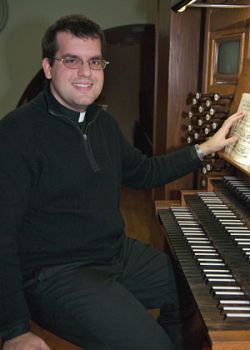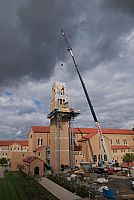Seminary life begins for Christopher Gray with pre-theology

SALT LAKE CITY — "Whether you’re new or almost finished with your seminary education, you’re always very sensitive to the feeling, the question: ‘Am I supposed to be here?" said Christopher Gray, a seminarian at Mount Angel Seminary, Oregon, studying for the priesthood for the Diocese of Salt Lake City. Gray’s face and his gifts are familiar to many of us. A graduate of the University of Utah with a Bachelor’s degree in mathematics and a minor in Spanish, Gray put in four years as a staff writer and information technologist for the Intermountain Catholic. During those years he not only edited the monthly Utah Católico and managed the IC web site, being recognized twice by the Catholic Press Association for excellence, he also developed the paper’s streaming video program and its podcast, "His Own Words," with Bishop John C. Wester. Gray worked closely with his mother, Maria-Cruz Gray, director of the Diocesan Office of Hispanic Ministry, and his father, Deacon Forrest Gray of the Diocesan Office of Continuing Education for Deacons. In the diocese for his first visit home since entering Mount Angel Seminary in August, Gray shared his first impressions of seminary life. "Everyone has an interesting story about a crisis of faith or a conversion experience," Gray said. "And everyone is acutely aware of a personal stop sign that says, ‘Is this for me? Am I for this? It’s like living in a pressure cooker." Gray’s university degree put him into the seminary’s theology program, the first year of which is pre-theology studies. His formation, he said, isn’t limited to his instructors, his advisors, his classmates, and the seminary faculty, who are all together all the time. "Everyone there forms us. Even the lay students who study at the seminary." Gray said he doesn’t pretend to understand yet all of the undercurrents of seminary life, "but it’s obvious there’s a lot going on there, and that’s exciting." "I arrived at the seminary in a car packed, modestly, I think, with just what I though I would need. We were met by seminarians at all levels of study who helped us unpack the car and carry everything up to my room in Anselm Hall. One of the men carrying my things was a deacon." Their week of orientation began with the Liturgy of the Hours. Later, their first week of classes began with Mass, a lecture by Abbot Nathan Zodrow of Mount Angel Abbey, a picnic, and evening prayer. During his first week at Mount Angel, the seminary and abbey were installing new bells in a tower named for the Visitation of Mary to Elizabeth. Gray documented the installation photographically. Like the abbey, the seminary’s hours are marked by the bells calling the monastic community to prayer seven times a day. "We live in community," Gray said. "We learn about being a person from the people around us. And we learn what shape prayer takes, and what brings sanctity. Now, we are building relationships." Gray said most of the men in Anselm Hall know his door is always open for those who drop by. "There is no television, which is fine with me because I was never much interested in television. Some of the men in Anselm Hall have had military experience. We have men there from Portland, Bend, Yakima, and cities and towns in California. All of us study with men and women from religious orders, and lay men and women. "Being around such a diversity of people seeking sanctity has given me a sense of forward vision," he said. "I find myself asking, ‘What does the Lord want me to do?’ Ideas come later." So early in their studies, Gray said, they are learning first how to be good people, "to build on our good qualities. We’re just beginning. Later, we will learn more about the pastoral aspects. Gray said the seminarians who have reached the diaconate stage of their studies have been very helpful, showing leadership to the new-comers. "They’ve been much more open, talking about their faith experiences." For a 26-year-old man who never had any trouble multi-tasking, Gray said he is grateful the seminary has allowed him to focus. "I can actually direct my thoughts to just one thing at a time." For Gray, and I suspect for most seminarians, the discernment process in which they are involved is deeply personal. "It’s like being in love," he said, "then, it’s not like being in love." "We’re all human, and we have infinate potential for disaster," he said with a laugh. "We all have our good and our bad, but it’s a brotherhood. We’re tied together by shared ministry and mission, but the temptations are still many. We work with and for each other." The seminary itself, he said, "is fabulous. It has a library that is amazing. It sits in a pastoral setting that is truly peaceful. I love it." The library at Mount Angel Seminary is filled with natural light and its book collections, some gathered from European abbeys hoping to preserve their collections during World Wars I and II by shipping them to abbeys in the United States, are extensive. Some collections housed in the Mount Angel Seminary Library are from abbeys and seminaries that did not survive the wars, Gray said. "The library has a Civil War collection that is fascinating, and an Aristotle collection that is a real treasure. We all want to be a part of the seminary, not just as students, but because we’re think somehow, someday, all of this will make a difference in our lives and in the lives of others." The seminary, too, has given Gray a sense of liberty, "an ability to make my own choices and the realization that we are all losing our liberty one choice at a time." In just a few months, he said, he’s gained far more than he’s lost. "There are rules to live by, and we find them year by year, I think. I haven’t heard for certain, but I believe seminarians are banned from all taverns in Mount Angel. "Our first rule is that we are supposed to be kind to people and to each other. We’re supposed to be the kind of people other people want to be around." Gray counts Greek as his favorite class so far. "It’s taught by our own Deacon Owen Cummings. He’s a jewel among jewels." His classes also include Latin, modern philosophy, ancient philosophy, and Christian spirituality. Other hours are spent studying, playing the chapel organ at least once a week (which takes him back to duties he’s served at St. Olaf Parish, Bountiful, Our Lady of Lourdes Parish, Magna, and a Bountiful Lutheran Church), leading a youth group in a parish in Salem, Ore., and participating in a vocal quartet. He also spends a lot of time "being present" to those around them, listening to them and being listened to. "Basically, there are four areas of priestly formation," Gray said. "There is academic formation, pastoral formation, spiritual formation, and human formation. It all ties into how to be, how to be a good person, how to be a good person in public and in the church, and how to be morally good. "Our teachers, our formators, and our academic advisors, our supervisors where we have pastoral duties, and our spiritual directors are all there to help us through the process. My spiritual advisor sees to the formation of my prayer life. Each of us has a formation director who sees to our human formation. It is all brought together because each area of our formation is equal to the others." Seminary life is a shared experience, Gray said, and it can be overwhelming. "We’re just trying to support each other right now, as seminarians, as part of the church at large, as parts of dioceses and religious orders. It is rigorous for us, especially in light of what the Catholic Church has been through in the last 10 years." On a day-by-day basis, Gray’s challenges are many, but he’s a man up to those challenges, and he’s learning more about himself and his relationship with God every day.
© Copyright 2024 The Diocese of Salt Lake City. All rights reserved.


Stay Connected With Us